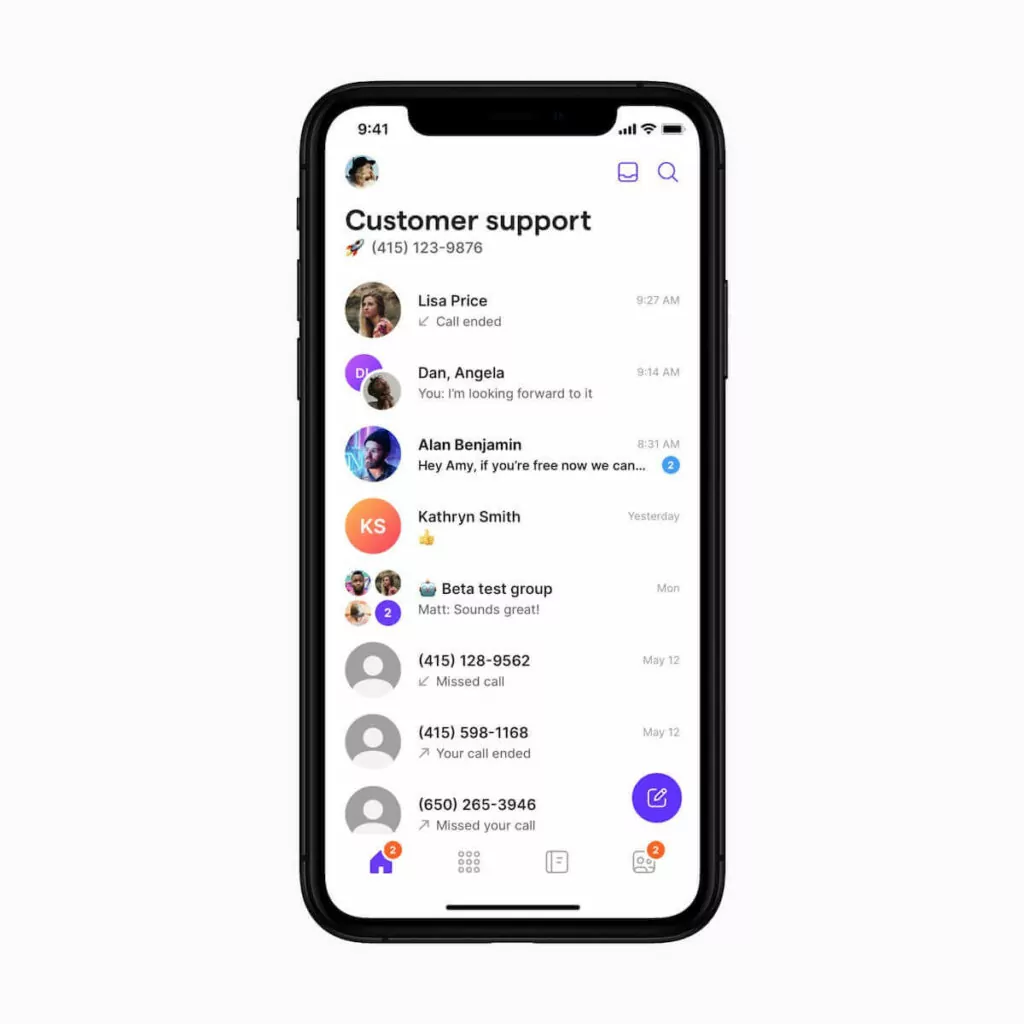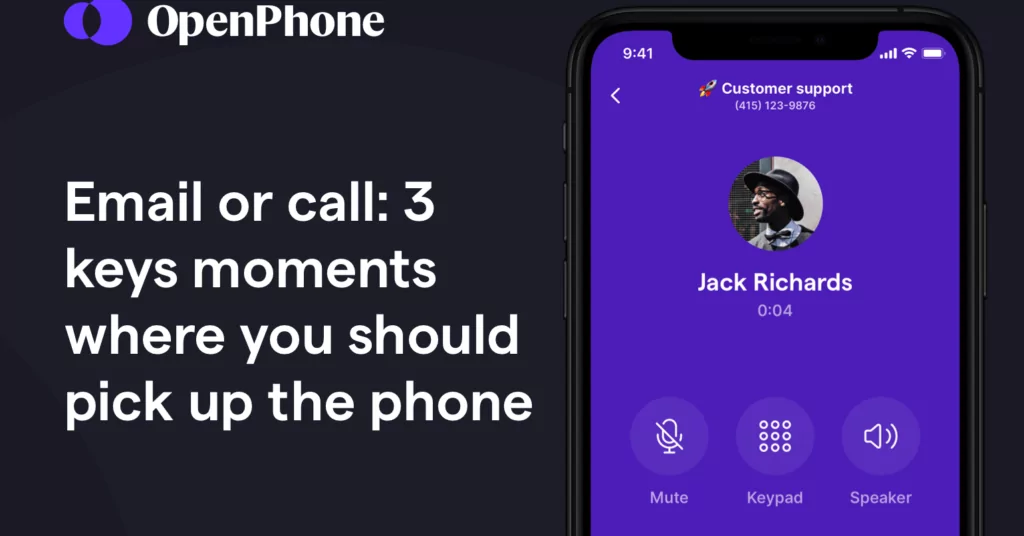When it comes to communicating with customers or teammates, you have a wealth of options at your disposal these days, from Slack and emails to Zoom and phone calls. However, for call-averse Millennials and Gen Z, an email will trump a phone call nine times out of ten.
Emails have their advantages, of course. They’re asynchronous, easy to find and review later, and — in those rare times that you might need it — they can provide a paper trail.
However, there’s a time and a place for everything. And even in today’s text-heavy world, there are three important moments where it’s worth picking up the phone over shooting off an email.
1. When you want someone to feel valued
Have you ever sent someone your call booking link and had them bristle at the need to book themselves into your calendar?
If you take a peek at Twitter, these discussions are constantly cropping up around scheduling apps like Calendly:
Chances are, you probably have an opinion on the (heated) debate above. But regardless of which side you fall on, there’s one important takeaway in the back-and-forth that many often miss: people want to feel important.
Whether they’re your coworker, client, investor, teammate, or employee, people want to feel that you value them and respect their time. With that in mind, pick up the phone in the following instances.
You’re covering something complicated
Emails and calls are great for complex conversations, but phone calls can reduce the frustration of a complicated discussion. For example, when you need to assist clients with an issue, real-time troubleshooting allows them to ask questions, explain what they’re experiencing, and find a solution all in one conversation.
The more quickly you resolve a customer’s (or teammate’s) problem, the more satisfied they’ll be (and the more valued they’ll feel). The customer experience becomes more positive, which builds trust and customer loyalty.
When the matter is urgent
When you’re debating whether to use email or call your contact, there’s one key question you need to ask: Is the situation time-sensitive?
Phone calls are ideal when you have an urgent message and you need an immediate response. Whereas a 24-hour response time is perfectly timely in both email and text messaging etiquette, phone calls occur in real time — and if your call recipient doesn’t pick up the phone, you can still leave a voicemail message to explain the urgency of the situation.
If strong feelings are involved
Strong feelings like distress or anger can damage a business relationship if handled poorly, so if negative emotions may be at play, it’s best to make a phone call to avoid assumptions and misinterpretations.
In the earlier years of my career, I generally defaulted to emails when I was dealing with unhappy clients or stressful situations — text communication felt like a bit of a shield from others’ negative emotions. However, as I gained more confidence, I found that a phone conversation was infinitely more useful when it came to actually solving a client’s problems (rather than just deflecting them).
The benefit to hopping on a call was two-fold. First of all, it let me dig into the scenario a bit deeper to understand what was really bothering the client — sometimes it takes some detective work to understand what lies at the core of someone’s frustration. Second, it let me use clear explanations and a considerate tone of voice to reassure the client that the problem would be solved.
If you need a record of your conversation in case of backlash, you can record your calls to get as much documentation as email can provide.
2. When you want to increase connection
During a busy workday, it’s easy to default to the easiest communication mode — whether that’s a quick email or a Slack DM. But according to a recent study, jumping to text-based communication sacrifices a crucial element of human interaction: connection.
The study found while 71% of people said they’d prefer to interact with an old friend or a stranger by email rather than a call, they actually felt significantly higher levels of connection when they picked up the phone. (It also didn’t take them any longer to call than it did to write an email.)
When Amit Kumar and Nicholas Epley, the researchers behind the study, asked participants to rate from one to nine how strong of a bond they felt and how deeply they reconnected when communicating over the phone versus email, participants consistently rated phone conversations more positively. Phone conversations were seen as a smidge more awkward than emails, but the difference was non-significant.
Of course, you don’t need to feel a strong sense of connection every time you interact with someone. A short project update or question is totally fine to send in an email. But if you’re hoping to grow your connection with someone (short or long term), don’t default to a quick message.
This doesn’t only apply to old friends or strangers, of course — it’s also important to keep in mind at work.
You’re coaching or connecting with your team
Whether you’re delivering feedback, having a weekly 1:1, or training a new team member, take the time to get on a voice or video call with your teammate.
It might seem easier to send a pre-recorded video or asynchronous note, but if you do, you’ll be missing out on a relationship-building opportunity. It can be all too easy when working on a remote team to let a catch-up call with a colleague slide, but feeling connected to the people we work with yields long-term benefits: teams that feel connected and engaged tend to be happier, more present, and more profitable.
As a leader, it’s worth your time.
You want to build rapport with customers
At OpenPhone, some of our earliest customers have become our biggest champions.
That’s because we made an effort to connect with them from Day 1. We not only gave them a direct line to us when they had problems, but we would frequently jump on calls with them to get their feedback, solve their problems, and simply get to know them.
The result? We built an open and connected community rather than just a user base.
You have good news to share
Ready to extend a job offer? Giving an employee a raise? Closed your fundraising round? Pick up the phone!
Sharing good news provides you with a unique opportunity to connect. Researchers have found that connecting over a piece of good news can strengthen bonds, boost optimism, and offset stress and anxiety.
3. When you need to make your case
While we all respect a good copywriter, there’s a reason why speeches — rather than company-wide emails — are used to rally people. When you hear the words of Nelson Mandela, Martin Luther King Jr., or Alexandria Ocasio-Cortez, you can hear every emotion in their voice — from courage to anger to urgency. And it makes you want to take action.
As a business owner, there will be plenty of times where you’ll need to be your own fiercest advocate or biggest champion.
In those moments — whether you’re chatting to investors, clients, or your own teams — opt to meet face-to-face or on a call.
When you’re pitching someone
When it comes to pitching a client, investor, or prospective employee, being able to convey and read emotion is crucial. And unfortunately — even with the helpful use of emojis 😉 — text-based communication leaves too much open to interpretation.
Pitching is an area where it can be easy to send an email almost as a cop-out. Early in my career, I used to send interested clients a pricing sheet and call it a day… but then bemoan the high number of prospective clients who simply ghosted me. In reality, though, my communication approach was probably to blame.
For instance, if a prospective client wrote back to my pitch saying, “Perfect, I’ll think about it,” I could take that phrase at face value and feel good about how everything had gone. But on a phone call, I might catch a hint of hesitation when that same person said the same phrase — giving me the opportunity to explore their doubts or renegotiate pricing. Similarly, a client may think that when I write, “Looking forward to working together,” I’m just using a generic sign-off. But on the phone, my tone can convey that collaborating with them really means the world to me.
To rally the troops
Anytime you need to make a big change at work, remember that no change happens in a vacuum. Whether you’re changing your pricing or your processes, keep change management best practices in mind.
That means communicating the importance of a change ahead of implementing it. Don’t simply send your team an email; get managers on the phone and explain why this change is taking place. By jumping on a call, you also give them the chance to ask questions and make suggestions.
By getting teams on board ahead of time, you increase your chances of a smooth transition and higher adoption of new processes.
When you need to brainstorm
When an in-person strategy session isn’t possible, brainstorming over a phone call beats an email exchange. Phone conversations allow your team members to bounce ideas off of each other in real time with more vulnerability, creating a better environment for cross-functional collaboration.
On a call, teammates also have the space to make the case for their most exciting, half-baked ideas. When an idea is simply a bullet point on a list, not everyone will be able to see the potential behind it. But when someone gets to pitch their vision with all the excitement and passion that comes with it, others can more easily buy into it.
Whether to email or call — that is the question

Whether you’re reaching out to your clients or your coworkers, choosing between an email or call can change how your message is perceived. Emails are still necessary for day-to-day digital communication, but phone calls are a far more conversational channel that allows for more empathy, connection, and persuasion.
With a VoIP provider like OpenPhone, you can make calls from anywhere and from virtually any device — from iPhones and Android phones to iPads and computers — as long as you have an internet connection. Plus, our business phone app can help you make the most of every call with features like call recording, free calls and texts to the US and Canada, contact notes, and shared phone numbers that allow you to collaborate on calls.
